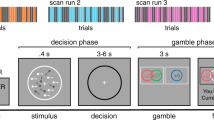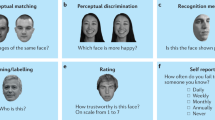Abstract
There is ample evidence that the average person thinks he or she is more skilful, more beautiful and kinder than others1,2 and that such overconfidence may result in substantial personal and social costs3,4,5,6,7,8. To explain the prevalence of overconfidence, social scientists usually point to its affective benefits, such as those stemming from a good self-image or reduced anxiety about an uncertain future9,10,11,12,13. An alternative theory, first advanced by evolutionary biologist Robert Trivers14,15,16, posits that people self-deceive into higher confidence to more effectively persuade or deceive others. Here we conduct two experiments (combined n = 688) to test this strategic self-deception hypothesis. After performing a cognitively challenging task, half of our subjects are informed that they can earn money if, during a short face-to-face interaction, they convince others of their superior performance. We find that the privately elicited beliefs of the group that was informed of the profitable deception opportunity exhibit significantly more overconfidence than the beliefs of the control group. To test whether higher confidence ultimately pays off, we experimentally manipulate the confidence of the subjects by means of a noisy feedback signal. We find that this exogenous shift in confidence makes subjects more persuasive in subsequent face-to-face interactions. Overconfidence emerges from these results as the product of an adaptive cognitive technology with important social benefits, rather than some deficiency or bias.
This is a preview of subscription content, access via your institution
Access options
Access Nature and 54 other Nature Portfolio journals
Get Nature+, our best-value online-access subscription
$29.99 / 30 days
cancel any time
Subscribe to this journal
Receive 12 digital issues and online access to articles
$119.00 per year
only $9.92 per issue
Buy this article
- Purchase on Springer Link
- Instant access to full article PDF
Prices may be subject to local taxes which are calculated during checkout


Similar content being viewed by others
Data availability
We report that all of the experimental data and all of the experimental conditions performed in this research project are included in the paper and its Supplementary Information. All data and codes to reproduce the analysis are available from the Open Science Framework (https://osf.io/k6hy5).
Code availability
Our STATA Do-file for the data analysis is downloadable from the Open Science Framework at https://osf.io/k6hy5.
References
Alicke, M. D. & Sedikides, C. Self-enhancement and self-protection: what they are and what they do. Eur. Rev. Soc. Psychol. 20, 1–48 (2009).
Baumeister, R. F. in The Handbook of Social Psychology (eds Gilbert, D. et al.) (McGraw-Hill, 1998).
Barber, B. M. & Odean, T. Boys will be boys: gender, overconfidence, and common stock investment. Q. J. Econ. 116, 261–292 (2001).
Glaser, M. & Weber, M. Overconfidence and trading volume. Geneva Risk Insur. Rev. 32, 1–36 (2007).
Biais, B., Hilton, D., Mazurier, K. & Pouget, S. Judgemental overconfidence, self-monitoring, and trading performance in an experimental financial market. Rev. Econ. Stud. 72, 287–312 (2005).
Malmendier, U. & Tate, G. Who makes acquisitions? CEO overconfidence and the market’s reaction. J. Financ. Econ. 89, 20–43 (2008).
Koellinger, P., Minniti, M. & Schade, C. ‘I think I can, I think I can’: overconfidence and entrepreneurial behavior. J. Econ. Psychol. 28, 502–527 (2007).
Dawson, C., de Meza, D., Henley, A. & Arabsheibani, G. R. The Power of (Non) Positive Thinking: Self-employed Pessimists earn more than Optimists IZA Discussion Paper No. 9242 (Forschungsinstitut zur Zukunft der Arbeit Institute for the Study, 2015).
Kunda, Z. The case for motivated reasoning. Psychol. Bull. 108, 480–498 (1990).
Taylor, S. E. & Brown, J. D. Illusion and well-being: a social psychological perspective on mental health. Psychol. Bull. 103, 193–210 (1988).
Brunnermeier, M. K. & Parker, J. A. Optimal expectations. Am. Econ. Rev. 95, 1092–1118 (2005).
Köszegi, B. Ego utility, overconfidence, and task choice. J. Eur. Econ. Assoc. 4, 673–707 (2006).
Bénabou, R. Groupthink: collective delusions in organizations and markets. Rev. Econ. Stud. 80, 429–462 (2013).
Trivers, R. in Social Evolution 395–420 (Benjamin/Cummings, 1985).
Trivers, R. The Folly of Fools: The Logic of Deceit and Self-Deception in Human Life (Basic Books, 2011).
Von Hippel, W. & Trivers, R. The evolution and psychology of self-deception. Behav. Brain Sci. 34, 1–16 (2011).
Babcock, L., Loewenstein, G., Issacharoff, S. & Camerer, C. F. Biased judgments of fairness in bargaining. Am. Econ. Rev. 85, 1337–1343 (1995).
Konow, J. Fair shares: accountability and cognitive dissonance in allocation decisions. Am. Econ. Rev. 90, 1072–1091 (2000).
Di Tella, R., Pérez-Truglia, R., Babino, A. & Sigman, M. Conveniently upset: avoiding altruism by distorting beliefs about others. Am. Econ. Rev. 105, 3416–3442 (2015).
Bénabou, R. & Tirole, J. Mindful economics: the production, consumption, and value of beliefs. J. Econ. Perspect. 30, 141–164 (2016).
Gino, F., Norton, M. I. & Weber, R. A. Motivated Bayesians: feeling moral while acting egoistically. J. Econ. Perspect. 30, 189–212 (2016).
Anderson, C., Brion, S., Moore, D. A. & Kennedy, J. A. A status-enhancement account of overconfidence. J. Pers. Soc. Psychol. 103, 718–735 (2012).
Burks, S. V., Carpenter, J. P., Goette, L. & Rustichini, A. Overconfidence and social signalling. Rev. Econ. Stud. 80, 949–983 (2013).
Ewers, M. & Zimmermann, F. Image and misreporting. J. Eur. Econ. Assoc. 13, 363–380 (2015).
Charness, G., Rustichini, A. & van de Ven, J. Self-confidence and strategic behavior. Exp. Econ. 21, 72–98 (2018).
Thoma, C. Under- versus overconfidence: an experiment on how others perceive a biased self-assessment. Exp. Econ. 19, 218–239 (2016).
Smith, M. K., Trivers, R. & von Hippel, W. Self-deception facilitates interpersonal persuasion. J. Econ. Psychol. 63, 93–101 (2017).
Keren, G. & Teigen, K. H. Why is p = .90 better than p = .70? Preference for definitive predictions by lay consumers of probability judgments. Psychon. Bull. Rev. 8, 191–202 (2001).
Brewer, N. & Burke, A. Effects of testimonial inconsistencies and eyewitness confidence on mock-juror judgments. Law Hum. Behav. 26, 353–364 (2002).
Radzevick, J. R. & Moore, D. A. Competing to be certain (but wrong): market dynamics and excessive confidence in judgment. Manage. Sci. 57, 93–106 (2011).
Tenney, E. R., Meikle, N. L., Hunsaker, D., Moore, D. A. & Anderson, C. Is overconfidence a social liability? The effect of verbal versus nonverbal expressions of confidence. J. Pers. Soc. Psychol. 116, 396–415 (2019).
Barrick, M. R., Shaffer, J. A. & DeGrassi, S. W. What you see may not be what you get: relationships among self-presentation tactics and ratings of interview and job performance. J. Appl. Psychol. 94, 1394–1411 (2009).
Sedikides, C., Hoorens, V. & Dufner, M. in Self-concept, Motivation and Identity: Underpinning Success with Research and Practice (eds Guay, F. et al.) 29–55 (Information Age Publishing, 2015).
Lamba, S. & Nityananda, V. Self-deceived individuals are better at deceiving others. PLoS One 9, e104562 (2014).
Drago, F. Self-esteem and earnings. J. Econ. Psychol. 32, 480–488 (2011).
de Araujo, P. & Lagos, S. Self-esteem, education, and wages revisited. J. Econ. Psychol. 34, 120–132 (2013).
Kaniel, R., Massey, C. & Robinson, D. T. The Importance of Being an Optimist: Evidence from Labor Markets. National Bureau of Economic Research Working Paper Series No. 16328 (National Bureau of Economic Research, 2010).
Möbius, M. M. & Rosenblat, T. S. Why beauty matters. Am. Econ. Rev. 96, 222–235 (2006).
Belot, M. & Van de Ven, J. How private is private information? The ability to spot deception in an economic game. Exp. Econ. 20, 19–43 (2017).
Aronson, E. & Mettee, D. R. Dishonest behavior as a function of differential levels of induced self-esteem. J. Pers. Soc. Psychol. 9, 121–127 (1968).
Becker, G. M., DeGroot, M. H. & Marschak, J. Measuring utility by a single-response sequential method. Behav. Sci. 9, 226–232 (1964).
Schlag, K. H., Tremewan, J. & an der Weele, J. J.. A penny for your thoughts: a survey of methods for eliciting beliefs. Exp. Econ. 18, 457–490 (2015).
DeYoung, C. G., Quilty, L. C. & Peterson, J. B. Between facets and domains: 10 aspects of the Big Five. J. Pers. Soc. Psychol. 93, 880–896 (2007).
Ekman, P. & Friesen, W. V. Nonverbal leakage and clues to deception. Psychiatry 32, 88–106 (1969).
Zuckerman, M., DePaulo, B. M. & Rosenthal, R. in Advances in Experimental Social Psychology Vol. 14 (ed. Berkowitz, L.) 1–59 (Academic, 1981).
McKay, R. T. & Dennett, D. C. The evolution of misbelief. Behav. Brain Sci. 32, 493–510 (2009).
Mercier, H. & Sperber, D. Why do humans reason? Arguments for an argumentative theory. Behav. Brain Sci. 34, 57–74 (2011).
Greiner, B. An online recruitment system for economic experiments. Forsch. Wiss. Rechn. 63, 79–93 (2003).
Fischbacher, U. z-Tree: Zurich toolbox for ready-made economic experiments. Exp. Econ. 10, 171–178 (2007).
Gibson, R., Tanner, C. & Wagner, A. F. Preferences for truthfulness: heterogeneity among and within individuals. Am. Econ. Rev. 103, 532–548 (2013).
Acknowledgements
P.S. and J.v.d.W. acknowledge support from the German Science Foundation (DFG) through grant CRC TR190. J.v.d.W. acknowledges support from the Dutch National Science Foundation (NWO) through a personal VIDI grant (452-17-004). The funders had no role in study design, data collection and analysis, decision to publish or preparation of the manuscript. We thank K. Barron, T. Buser, S. Chassang, A. Coutts, B. Enke, B. Kőszegi, Y. Le Yaouanq, G. Loewenstein, J. Maier, D. de Meza, T. Murooka, K. Schmidt, P. Seabright, J. van de Ven, A. Wuppermann, F. Zimmermann and several seminar audiences for helpful comments. J. Hannane provided research assistance.
Author information
Authors and Affiliations
Contributions
P.S. and J.v.d.W. conducted the experiments and contributed to the conception, design, analysis and writing of the paper in equal parts.
Corresponding author
Ethics declarations
Competing interests
The authors declare no competing interests.
Additional information
Peer review information: Primary Handling Editor: Aisha Bradshaw.
Publisher’s note: Springer Nature remains neutral with regard to jurisdictional claims in published maps and institutional affiliations.
Supplementary information
Supplementary Information
Supplementary Methods, Supplementary Results, Supplementary Discussion, Supplementary Tables 1–7, Supplementary Figs. 1–3 and Supplementary References.
Rights and permissions
About this article
Cite this article
Schwardmann, P., van der Weele, J. Deception and self-deception. Nat Hum Behav 3, 1055–1061 (2019). https://doi.org/10.1038/s41562-019-0666-7
Received:
Accepted:
Published:
Issue Date:
DOI: https://doi.org/10.1038/s41562-019-0666-7
This article is cited by
-
The case for partisan motivated reasoning
Synthese (2023)
-
Minimizing responsibility in the aggressive dynamics of bullying and its impact on other strategies of moral disengagement: a longitudinal study
Current Psychology (2023)
-
Predictors and consequences of intellectual humility
Nature Reviews Psychology (2022)
-
Extremists are more confident
Erkenntnis (2022)
-
Self-serving dishonesty: The role of confidence in driving dishonesty
Journal of Risk and Uncertainty (2022)



